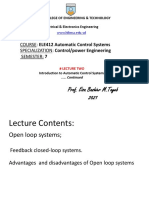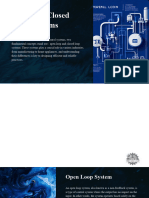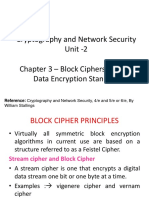Copy Mis Assignment
Uploaded by
bonkayproductionsCopy Mis Assignment
Uploaded by
bonkayproductionsOPEN LOOP CONTROL SYSTEM
In open loop control system, the output does not affect the control action of the system. In other
words, the system whose working depends on time is known as the open loop control system.
The open loop system is free from the feedback. Let’s understand this with the help of the few
examples.
Example 1: Consider the clothes dryer whose control action is done manually by the operator.
Depending on the wetness of the clothes suppose the operator set the timer for 30 minutes. After
30 minutes the timer will stop even after the clothes are wet.
The dryer stops working even if the desired output is not obtained. This shows that the system
has no feedback. Here, clothes dryer is the example of the open loop system and the timer is the
controller of the system.
Example 2: The automatic washing machine is the example of the open loop system. The
operator manually sets the operating time of the machine. The machine stops operating after the
set time, even the desire cleanliness of clothes are not obtained. This happens because the
machine has no feedback system which signals the control action of the system for desired
output.
The open loop system is simple, require less maintenance. Also, it is fast in operation and very
economical. But the accuracy of the system is less, and it is less reliable.
CLOSED LOOP CONTROL SYSTEM
The closed-loop control system means the output of the system depends on their input. The
system has one or more feedback loops between its output and input. The closed-loop system
design in such a way that they automatically provide the desired output by comparing it with the
actual input. The closed-loop system generates the error signal which is the difference between
the input and output.
Example 1: Suppose in the above example of closed dryer we are using the transducer which
senses the dryness of the clothes and provides the feedback signal to the controller relating to
dryness. Here the dryness is the output of the system. The sensor act as a feedback of the system.
The sensor gives the signal to the controller of the machine, and hence the dryer provides the
desired output.
Example 2: The air conditioner is the example of the closed-loop system. The air conditioner
regulates the temperature by comparing it with the surrounding temperature. The comparison of
temperature is done with the help of the thermostat. When the AC provides the error signal
which is the difference between the surrounding temperature and room temperature the
thermostats turn on or off the compressor.
The closed loop system is more reliable and accurate. But this system is very expensive and
requires high maintenance.
Key Differences between Open Loop and Closed Loop System
1. The open loop system means the output of the system is free from their input. In the
closed-loop system, the desired output depends on their input.
2. The open loop system is called the non-feedback system while the closed loop is the
feedback system.
3. The control and controlled process are the two components of the open loop system. The
closed loop requires some components likes an amplifier, controller, controlled process,
feedback system etc.
4. The construction of systems is easy because few elements are used in the system. The
construction of the closed-loop system is quite difficult.
5. The open loop system is not reliable whereas the closed-loop system is reliable.
6. The accuracy of the system is less as compared to the closed-loop system.
7. The open loop system is more stable as compared to a closed loop system. Here the word
stable means the output of the system remains constant even after the disturbances.
8. The open loop system is not optimized, whereas the closed-loop system is optimized.
9. The open loop system gives the fast response, whereas the closed loop system gives the
slow response.
10. The calibration of open loop system is difficult as compared to the closed-loop system.
11. In an open loop system, the disturbance affected the output, whereas in a closed loop
system the output is not much affected by the disturbances.
12. The output control system has a non-linear response, whereas the input control system
has linear responses.
13. The traffic light, automatic washing machine, etc. are the examples of the output system,
whereas the temperature controller, toaster etc. are the examples of the closed-loop
system.
Conclusion
The open loop and control loop are the two types of control system. The open loop system works
on input, and it is simple in construction while the closed loop system is complex and their
output depends on the input.
You might also like
- Course Name: A-Level (1 Sem.) Subject: Iot Topic: Open and Closed Loop System Date: 19.05.2020No ratings yetCourse Name: A-Level (1 Sem.) Subject: Iot Topic: Open and Closed Loop System Date: 19.05.20203 pages
- Difference Between Open Loop & Closed Loop System (With Comparison Chart) - Circuit GlobeNo ratings yetDifference Between Open Loop & Closed Loop System (With Comparison Chart) - Circuit Globe14 pages
- Control Systems: Closed - Loop System and Open - Loop SystemNo ratings yetControl Systems: Closed - Loop System and Open - Loop System4 pages
- Closed Loop and Open Loop Control System PDF File SirNo ratings yetClosed Loop and Open Loop Control System PDF File Sir3 pages
- 1.1.3.10 Lab - Compare Closed-Loop and Open-Loop Control Systems100% (1)1.1.3.10 Lab - Compare Closed-Loop and Open-Loop Control Systems1 page
- 1.1.3.10 Lab - Compare Closed-Loop and Open-Loop Control Systems - ILMNo ratings yet1.1.3.10 Lab - Compare Closed-Loop and Open-Loop Control Systems - ILM2 pages
- Basis For Comparison Open Loop System Closed Loop SystemNo ratings yetBasis For Comparison Open Loop System Closed Loop System4 pages
- Lab - Compare Closed-Loop and Open-Loop Control Systems ObjectiveNo ratings yetLab - Compare Closed-Loop and Open-Loop Control Systems Objective2 pages
- Closed-Loop System and Closed-Loop Control SystemsNo ratings yetClosed-Loop System and Closed-Loop Control Systems9 pages
- Mis Feedback Control System - PowerpointNo ratings yetMis Feedback Control System - Powerpoint9 pages
- Control Engineering - Open Vs Closed LoopNo ratings yetControl Engineering - Open Vs Closed Loop14 pages
- Introduction To Control System:: "Plant"-And A Sensor That Measures What The Controlled System IsNo ratings yetIntroduction To Control System:: "Plant"-And A Sensor That Measures What The Controlled System Is8 pages
- Introduction To Control Engineering and System Modeling (1) : Majid Midhat SaeedNo ratings yetIntroduction To Control Engineering and System Modeling (1) : Majid Midhat Saeed7 pages
- 1.1.3.10 Lab Compare Closed Loop and Open Loop Control SystemsNo ratings yet1.1.3.10 Lab Compare Closed Loop and Open Loop Control Systems1 page
- Lesson 1. Introduction To Control SystemNo ratings yetLesson 1. Introduction To Control System17 pages
- But The Goal of Any Electrical or Electronic Control System Is To MeasureNo ratings yetBut The Goal of Any Electrical or Electronic Control System Is To Measure8 pages
- 1.1.3.10 Lab - Compare Closed-Loop and Open-Loop Control SystemsNo ratings yet1.1.3.10 Lab - Compare Closed-Loop and Open-Loop Control Systems2 pages
- Chapter 9 - Introduction To Control SystemsNo ratings yetChapter 9 - Introduction To Control Systems39 pages
- El402: Embedded System Design CREDITS 5 (L 3, T 0, P 2)No ratings yetEl402: Embedded System Design CREDITS 5 (L 3, T 0, P 2)2 pages
- Soc105 - r5 - Consumption and Mass Media Worksheet100% (1)Soc105 - r5 - Consumption and Mass Media Worksheet3 pages
- Schein (2010:6), Organizational Culture Can Be Defined As "A Pattern of Shared BasicNo ratings yetSchein (2010:6), Organizational Culture Can Be Defined As "A Pattern of Shared Basic5 pages
- International Relations Syllabus - Hudakova - 2020No ratings yetInternational Relations Syllabus - Hudakova - 20204 pages
- Database Design For Dynamic Online Surveys: Conference PaperNo ratings yetDatabase Design For Dynamic Online Surveys: Conference Paper9 pages
- Electric-Fusion-Welded Steel Pipe For Atmospheric and Lower TemperaturesNo ratings yetElectric-Fusion-Welded Steel Pipe For Atmospheric and Lower Temperatures7 pages
- Cryptography and Network Security Unit - 2 Chapter 3 - Block Ciphers and The Data Encryption StandardNo ratings yetCryptography and Network Security Unit - 2 Chapter 3 - Block Ciphers and The Data Encryption Standard86 pages
- Overview of Mergers and Acquisition and MNo ratings yetOverview of Mergers and Acquisition and M11 pages
- Pan Pearl River Delta Physics Olympiad 2014: V 10 M/s VNo ratings yetPan Pearl River Delta Physics Olympiad 2014: V 10 M/s V10 pages

























































































